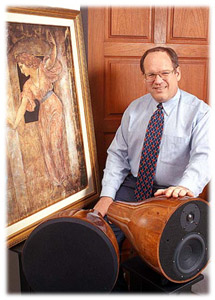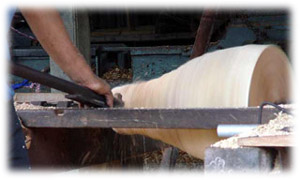Interview with Michael Barnes of nOrh
Loudspeaker Company
 Srajan Ebaen: Michael, how did
a computer specialist end up running his own loudspeaker company in addition to his daily
workload? Srajan Ebaen: Michael, how did
a computer specialist end up running his own loudspeaker company in addition to his daily
workload?
Michael Barnes: I was always interested in
electronics and technology. I was also very much into audio and worked in an audio store
for four years. [As an audio salesman], I would ask my customers about their jobs. All of
them made far more money than I did -- I could never afford to buy any of the equipment I
sold. Many of them worked for computer companies but at that time few of the professional
computer people knew or understood PCs. I did, so I was able to get into a professional
position. Now I had a job that gave me the necessary income for audio.
Then the Thai economy failed and our currency eroded
against the dollar. I knew that before long, imported goods would cost Thais twice as much
as before. I believed there could be a market for a high-quality loudspeaker manufactured
right here in Thailand. While I was mulling over this idea, I attended a Fong Nam concert
(a group led by American Bruce Gaston, which uses Thai and Western instruments to play
classical Thai music and jazz.). This was the first time I noticed the Thai Long Drum. As
soon as I saw it, I was convinced it would be the ideal shape for a loudspeaker. I knew an
engineer who had just finished school and needed a job. I hired him and together we worked
out the details of the cabinet.
Our problem was that we didn't really know about
crossovers. We tested ideas by buying used speakers and putting their drivers and
crossovers into our cabinets to see if the sound improved. It did in all instances. We
then figured out which drivers we wanted to use and built a crude crossover prototype. We
went to Allen Isakson, the president of DACT, asking him to test the speaker and advise
us, if necessary. He redesigned [the crossover]. We now had our 6.5. We took some
pictures, put up a website and opened a store. We thought we might sell ten pairs of
speakers per month. This would be enough to create four or five jobs and was all I was
really looking to accomplish.
Once the website went live, I was amazed at the sales.
Eventually, our Internet sales were so good that we had nothing left to show or sell in
the store -- so we closed it. To this day, I still take no money from nOrh because I want
the company to continue growing so I can employ more people. We can hire many Thais for
what my salary would normally be. I prefer creating more jobs instead.
I recently left Sun Microsystems after 13 years, so I could
devote myself to my own project ideas. I am currently trying to develop an x86-based
server that should be about the size of the original Palm Pilot. I would like to put this
server into production here in Thailand, which would create even more jobs.
SE: How big is nOrh?
MB: We did $80,000 USD in our first six
months and about $260,000 in our second year. We finished last year with about $550,000
[in sales]. We believe we will top one million dollars this year. We employ about 12
people directly, but create jobs for about 35 people altogether.
SE: What does the name "nOrh"
mean?
MB: I came up with ten names that I wanted
to register for our website -- and they were all already taken, so I realized I had to
invent a word. Since we refer to our design as an inverted horn, I thought we could mix up
the letters in 'horn' to come up with a name. I came up with nOrh. We made the 'O' larger
because it looked like the shape of our speaker.
SE: Is there much appreciation for your
products in Thailand proper, or do you sell most of your products overseas?
MB: Thais don't appreciate Thai products.
Many good audio products are made in Thailand without the country of origin being
acknowledged. The company that produces our CD players builds several other high-end CD
players. Most people just assume they are made in the US. Our nOrh products are 100%
handcrafted. We have wanted to make this our company theme. The level of craftsmanship
that still exists in Thailand has disappeared from most of the rest of the world. We don't
try to be efficient because our goal is to create jobs. I don't know how many more years
Thailand will be able to preserve this level of high craftsmanship. Better-paying jobs
will lure future generations away from these crafts. I don't think that loudspeakers such
as ours will ever be built again. Eventually, there will be no place on earth where you
could get such products made.
SE: Looking at the ceramic review pair,
I couldn't envision how they're actually put together.
MB: All of our loudspeakers are very
difficult to produce. As I said, efficiency isn't one of our goals. Creating employment
is. We spent a year developing the ceramic loudspeaker. The most difficult part was
accounting for the 25% shrinkage that occurs during the firing process. Through trial and
error, we worked out how to make the holes align. We went through a series of molds to
determine the correct size.
There are many other things that can go wrong. The drum can
crack if the glaze shrinks faster than the vessel. The drum can also collapse from its own
weight during the firing process. The glaze can run. To build the speaker, we mold three
pieces. The drum, tweeter mount and port are all separate molds. The pieces are then
assembled and glazed.
SE: The more upscale models don't use
the pod-type tweeter. That seems like a very high-tech feature, especially on the
affordable Model 4.0. Why isn't it carried over to the more expensive designs?
MB: The tweeter needed to be mounted above
the drum because the baffle was too small to support both woofer and tweeter. We do think
that given what we wanted to accomplish, we have been able to style the speaker in a way
that makes it look modern. The more expensive speakers use larger and better tweeters.
Those are designed to be mounted on a baffle, while the smaller tweeter is designed to be
mounted in its own sub-enclosure.
SE: I noted that the bullet tweeter on
the Model 4.0 is physically offset from the mid/woofer as though it were time-aligned.
However, your specifications don't claim time or phase coherence.
MB: Without very sophisticated equipment,
there really is no easy way to know what the acoustic center of a driver is, so as to
correctly calculate the time differences. Most companies that claim to have time-aligned
their drivers really don't know if they have them time-aligned or not. We knew that people
would assume that our speakers were time-aligned. Maybe they are, maybe they aren't. The
fact that most people think they are just goes to show how effective audio hype is.
 SE: How would you
describe the sonic differences between the wooden, ceramic and marble versions of the
Model 4.0? SE: How would you
describe the sonic differences between the wooden, ceramic and marble versions of the
Model 4.0?
MB: The wood version got very good
reviews. It is our only product that was reviewed in one of the popular US audio
magazines, The Abso!ute Sound. We then decided to place the same components into
marble. We were shocked at the improvements. The sound became much more realistic,
articulate and natural. Of course marble is a lot more expensive than wood so I did a lot
of research on the acoustic absorption coefficients of other materials that might be less
expensive to produce. The best materials turned out to be stone, cement, sand and
ceramics. I investigated ceramics and found that while there had been earlier ceramic
loudspeakers, they were often very expensive. Most of them used full-range drivers and
glued the drivers in place because the manufacturers couldn't figure out how to attach the
woofer. We perfected our process and can now offer truly affordable ceramic loudspeakers.
Our customers agree that the ceramic and marble loudspeakers sound identical. Of course
the ceramic versions are less expensive and also offer more color options.
SE: Weren't there some problems with
the wood speakers?
We had some problems early on, but improving our curing
process eliminated nearly all cracking. We did find that the likelihood of cracking
increases with size. Larger vessels contain more cabinet moisture and have more surface
area. However, the wood versions of the 3.0, 4.1 and 5.1 models haven't suffered any
cracking. When we do encounter an occasional problem, we offer a replacement or credit
towards an upgrade.
SE: I was surprised at how loud the
Model 4.0 can play. Do you have specific design explanations for why that is so?
MB: This is something that most customers
notice. There are several reasons for this. In standard box-shaped speakers, the energy
generated by the inward-moving woofer reflects off the rear cabinet wall and returns again
into the backside of the woofer. This means that as you drive the speaker harder, more and
more energy is fighting the woofer. There are four different sources of cabinet-induced
losses of acoustic output. The first is absorption. The stuffing used inside conventional
speakers converts acoustic energy into heat. We don't need to stuff our speakers because
of their shape. Another source is cabinet leaks. We don't have seams in our speakers and
we also attach our drivers more securely than most, with threaded steel instead of
MDF-anchored wood screws. Our vents are made from acoustically dead materials to avoid the
energy absorption of conventional ports. You might also notice that the shape of our
speaker resembles a jet engine. This shape minimizes the losses that a normal vented
system would suffer. All this adds up to higher than usual output level capabilities for
the level of transducers and cabinet size we use.
SE: Do you have any recommendations for
music from Thailand that our readers might enjoy?
MB: Most Thai music is really not that
well recorded. There are exceptions. Fong Nam is available outside of Thailand. Boy Thai
is another of nOrh's favorite Thai groups. We make their CDs available to our customers
and their reactions have been very favorable. I believe that there is a lot of interesting
music here in Thailand as long as you stay away from Thai pop. That's as dreadful as
American pop.
|